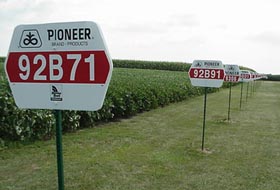|
Area
farmers see more than a colorful display of signs when they review
plots. They see the tests as a powerful source of information that
will help them make wise business decisions for the 2001 crop.

[Logan
County farmers listen to a Monsanto agronomist discuss a herbicide
treatment.]
Plots
are labor-intensive selling efforts on behalf of the companies who
sponsor them.
One
of the best seed plots in Logan County belongs to Pioneer seed
dealer Bill Rademaker. His neat-as-a-pin corn and soybean display is
adjacent to Interstate 155 between Hartsburg and Emden. In lieu of a
rugged road ditch, Rademaker and his helpers maintain a well-groomed
yard that extends from the edge of Route 121 to the plot. And, all
the signs stand erect in a perfectly straight row.

[Each
sign tells a story about the genetic makeup of the hybrid.
On Pioneer signs, the larger the first number, the fewer days
it takes for the corn to mature.]
Throughout
the summer, Rademaker will give a personalized plot tour to farmers
who stop to visit. But a major plot tour on Aug. 21 will bring
together Pioneer agronomists and a larger group of farmers to
discuss the pros and cons of each variety. Farmers use these events
to determine which new varieties have the most yield potential when
grown on their farm.

Bill
Rademaker has 25 years of experience in planning and managing a
plot. Each year, he chooses several corn hybrids within each
maturity range to profile. Some have the popular new bt gene, others
do not. All of the numbers are compared to an old standby hybrid
that has historically performed well in this area.

Planting
the plot is a meticulous process. Rademaker and his helpers have
created a shortcut. Rather than dumping individual seed boxes after
the single pass down the plot, they have rigged up a generator and
shop vac for quick seed cleanups at the end of each row.
(To
top of second column)
|

As
the crop matures, signs identifying the particular hybrid are posted
in front of the plot. The numbers and letters on the signs are not
randomly picked out of a hat. They represent the number of days it
takes a particular hybrid to reach maturity or a specific gene trait
that was added to the hybrid.
Farmers
use these numbers to select the right corn or soybeans, just like
the fashion-conscious person relies on designer labels to build
their wardrobe.
Rademaker
will harvest this plot one variety at a time and dump it into a
special wagon that will help to determine the actual yield of the
very small area. This information is not as valuable as taking the
yield on an entire field of one variety, but it does serve to
compare the many different varieties in one plot.

Rural
Atlanta farmer Dean Sasse doesnít give much credence to corn and
soybean variety plot results because they arenít replicated. Sasse
conducts a lot of on-farm research to make decisions for his farm.
This year, he is evaluating the need for an at-plant corn soil
insecticide to control the western corn rootworm, and the yield
benefits of using starter fertilizer.
Sasse
was also one of 35 farmers from the Land of Lincoln Soil Savers
group that visited Monsantoís research farm in Monmonth on July
27. "Those plots were very impressive because they were
replicated," commented Sasse. Monsanto displays more than 300
herbicide treatments at the site. In between each treatment was a
check strip to measure the actual weed pressure where no herbicide
was applied.
Yet
another excellent source of information are trials conducted by the
University of Illinois and county extension groups. These results
are always published and can provide another data check for those
varieties that performed well in company sponsored plots like
Rademakerís.
There
are many seed, chemical and fertilizer products out on the market
for farmers to evaluate. If these products are not displayed in a
number of farmer and university trials, itís likely that they will
not grow in market share as a company expects.

[Bill
Rademaker prepares the ears of corn for display so that farmers can
examine how well the ear has developed.]
One
thing is for sure, as long as farming is driven by large
corporations, there will continue to be lots of demonstration plots
with colorful signs to attract our attention as we cruise down rural
roadways.
[Marty
Ahrends]
|

